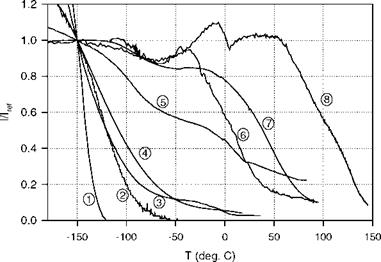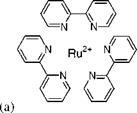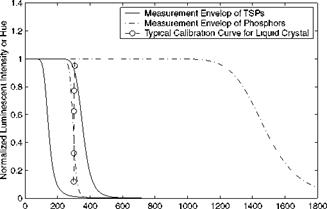Typical Temperature Sensitive Paints
Like PSP, TSP is prepared by dissolving a luminescent dye and a binder in a solvent. Many commercially available resins and epoxies can serve as polymer binders for TSP if they are not oxygen permeable and do not degrade the activity of the probe luminophore molecule. Table 3.2 lists some TSP formulations as well as the spectroscopic properties, temperature sensitivities and useful temperature measurement ranges. Data are collected from Campbell (1993) and Gallery (1993) and other sources. For a comparison between different TSP formulations, the maximum logarithmic slope max{ d[ln( I / Iref )] / dT } is used as an indicator of the temperature sensitivity for TSP over a certain temperature range, where Iref is the reference luminescence intensity. Here, the logarithmic
slope is used since it is independent of the reference intensity that is different in various sources. Two proprietary TSP formulations and two high-temperature thermographic phosphors are also included in Table 3.2 for comparison. Figure 3.13 shows typical temperature dependencies of the luminescent intensity for a number of TSP formulations. Some of them have been used to measure the temperature and heat transfer fields in various applications (Kolodner and Tyson 1982, 1983a, 1983b; Romano et al. 1989; Campbell et al. 1993, 1994; Liu et al. 1995a, 1995b, 1996; Hamner et al. 1994; Asai et al. 1996, 1997c).
|
Table 3.2. Temperature sensitive paints
|
|
Fig. 3.13. Temperature dependencies of the luminescence intensity for TSP formulations: (1) Ru(trpy) in Ethanol/Methanol, (2) Ru(trpy)(phtrpy) in GP-197, (3) Ru(VH127) in GP – 197, (4) Ru(trpy) in DuPont ChromaClear, (5) Ru(trpy)/Zeolite in GP-197, (6) EuTTA in dope, (7) Ru(bpy) in DuPont ChromaClear, (8) Perylenedicarboximide in Sucrose Octaacetate. (Tref = -150oC). From Liu et al. (1997b) |
Two typical TSP formulations are Ru(bpy) in an automobile clear coat (DuPont ChromaClear) binder and EuTTA in model airplane dope (see Appendix B); both are easy to prepare and use. Figure 3.14(a) shows the chemical structure of tris(2,2’-bipyridyl) ruthenium or Ru(bpy) and Figure 3.14(b) shows the absorption and emission spectra of Ru(bpy) that are similar to those of Ru(dpp) for PSP. Ru(bpy) can be excited by a UV lamp, nitrogen laser, argon laser, doubled YAG laser or blue LED array. Since the Stokes shift is large (the emission peak at about 620 nm), the excitation light can be easily separated from the luminescent emission using an optical filter. An automobile urethane clear coat, which is usually used as a top coat on most automobiles, is used as a polymer binder for Ru(bpy); particularly, DuPont ChromaClear 7500S is used, but other brands should work as well. The advantage of this binder is that it is oxygen impermeable, readily available, and easy to spray although some pressure sensitivity was observed at very high pressures and temperatures. Figure 3.13 shows the temperature dependency of the luminescent intensity for Ru(bpy) in DuPont ChromaClear along with other TSP formulations. Ru(bpy) can also mixed with a Shellac binder; the Ru(bpy)-Shellac TSP is similar to Ru(bpy) in DuPont ChromaClear in terms of the temperature sensitivity. It is also easy to apply. Figures 3.15 and 3.16 show, respectively, the Arrhenius plot and lifetime for the Ru(bpy)-Shellac TSP compared with the EuTTA-dope TSP.
|
|
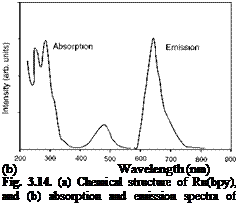 |
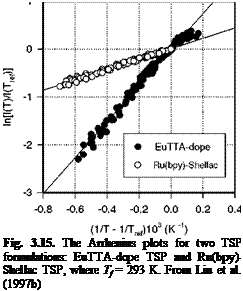 |
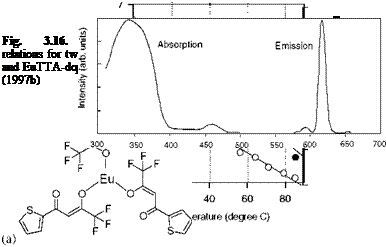 |
(b) Wavelength (nm)
Fig. 3.17. (a) Chemical structure of EuTTA, (b) absorption and emission spectra of EuTTA
Another good TSP is based on Europium (III) Thenoyltrifluoroacetonate or EuTTA whose structure and the absorption and emission spectra are shown in Fig. 3.17. Obviously, a UV lamp or a nitrogen laser can be used for excitation. EuTTA has a high quantum yield and a large Stokes shift (the emission peak at about 620 nm). The binder used with this luminphore is a clear model airplane dope that, like DuPont ChromaClear and Shellac, is readily available, easy to spray, and oxygen impermeable. Figures 3.15 and 3.16 show, respectively, the Arrhenius plot and lifetime for the EuTTA-dope TSP along with those for the Ru(bpy)-Shellac TSP.
Thermographic phosphors and thermochromic liquid crystals are also temperature sensitive coatings for measuring the surface temperature distributions. Similar to polymer-based TSPs, thermographic phosphors utilize the thermal quenching of the luminescent emission from ceramic materials that are doped or activated with rare-earth elements (Allison and Gillies 1997). However, they are usually in the form of insoluble powders or crystals in contrast to a polymer-based TSP where luminescent molecules are immobilized in a polymer matrix. The luminescent intensity (or lifetime) of thermographic phosphor and polymer-based TSP follows the same functional relation I ^ [1 + a0exp(-a1/T)]- . Figure 3.18 shows the measurement envelops of thermographic phosphors and polymer – based luminescent TSPs. A family of thermographic phosphors can cover a temperature range of 273-1600 K, which overlaps with the temperature range of the polymer-based TSP family from 90 to 423 K. Hence, a combination of thermographic phosphors and polymer-based luminescent TSPs can cover a very broad range from cryogenic to high temperatures. The measurement systems (intensity – and lifetime-based systems) for thermographic phosphors are essentially the same as those for polymer-based luminescent TSPs. The emission spectrum of certain phosphor has multiple distinct lines that have very different temperature sensitivities. Thus, an emission-intensity ratio between the temperature-sensitive and – insensitive lines can eliminate the effect of nonuniform illumination on a surface. Note that certain emission lines of certain phosphors are also temperature sensitive in cryogenic conditions. Thermochromic liquid crystals selectively reflect light depending on the surface temperature, and hence the dominant wavelength or hue of the reflected light varies monotonically with temperature over a relatively narrow temperature range of about 32-42oC (Smith et al. 2000). For comparison, Figure 3.18 plots the normalized hue of a typical thermochromic liquid crystal as a function of temperature; the temperature sensitivity of the thermochromic liquid crystal is high over a narrow temperature range.
|
Temperature (Kelvin) Fig. 3.18. Measurement envelops for polymer-based TSPs and thermographic phosphors along with a typical normalized calibration curve of thermochromic liquid crystal |











